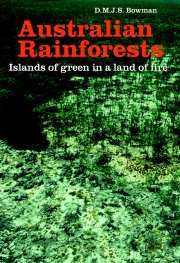Book contents
- Frontmatter
- Contents
- Preface
- 1 Introduction
- 2 What is Australian rainforest?
- 3 The sclerophyll problem
- 4 The edaphic theory I. The control of rainforest by soil phosphorus
- 5 The edaphic theory II. Soil types, drainage, and fertility
- 6 The climate theory I. Water stress
- 7 The climate theory II. Light and temperature
- 8 The fire theory I. Field evidence
- 9 The fire theory II. Fire, nutrient cycling, and topography
- 10 The fire theory III. Fire frequency, succession, and ecological drift
- 11 The fire theory IV. Aboriginal landscape burning
- 12 The fire theory V. Aridity and the evolution of flammable forests
- 13 The fire theory VI. Fire management and rainforest conservation
- 14 Summary
- References
- Index
5 - The edaphic theory II. Soil types, drainage, and fertility
Published online by Cambridge University Press: 23 November 2009
- Frontmatter
- Contents
- Preface
- 1 Introduction
- 2 What is Australian rainforest?
- 3 The sclerophyll problem
- 4 The edaphic theory I. The control of rainforest by soil phosphorus
- 5 The edaphic theory II. Soil types, drainage, and fertility
- 6 The climate theory I. Water stress
- 7 The climate theory II. Light and temperature
- 8 The fire theory I. Field evidence
- 9 The fire theory II. Fire, nutrient cycling, and topography
- 10 The fire theory III. Fire frequency, succession, and ecological drift
- 11 The fire theory IV. Aboriginal landscape burning
- 12 The fire theory V. Aridity and the evolution of flammable forests
- 13 The fire theory VI. Fire management and rainforest conservation
- 14 Summary
- References
- Index
Summary
Andrews (1916) eloquently expressed the idea that soil fertility was critical in delimiting rainforest when he wrote that around Sydney:
there are sheltered areas or pockets of volcanic soil or shales, on which dense luxuriant plant growths abound forming canopies of dark and glossy green, which exclude a great proportion of the sun's rays. Surrounding these patches are the hungry sandstones forming so much of the large Sydney and Blue Mountains district, whose vegetation is in striking contrast with that of the rich soils. Here is to be seen no luxuriant foliage, no twining nor towering canopy to the jungle, but instead merely an array of Eucalyptus, phyllodineous acacias, banksias of sombre hue and casuarinas.
Subsequently, a number of ecologists have also advocated the idea that soil fertility is critical in determining the distribution of rainforest vegetation (McLuckie and Petrie 1927; Davis 1936; Fraser and Vickery 1938, Pidgeon 1940; Herbert 1960; Florence 1964, 1965; Webb 1968). The object of this chapter is to show that Australian rainforests are not consistently limited by soil texture, drainage, or soil fertility.
Geology and soil types
While it is true that the largest tracts of rainforest in Australia are, and were before being cleared, associated with fertile basaltic soils, the importance of soil parent material in controlling rainforest has been over-emphasised.
- Type
- Chapter
- Information
- Australian RainforestsIslands of Green in a Land of Fire, pp. 84 - 98Publisher: Cambridge University PressPrint publication year: 2000



